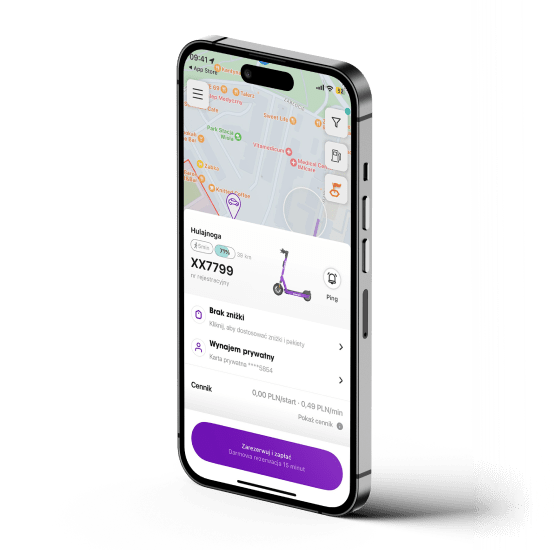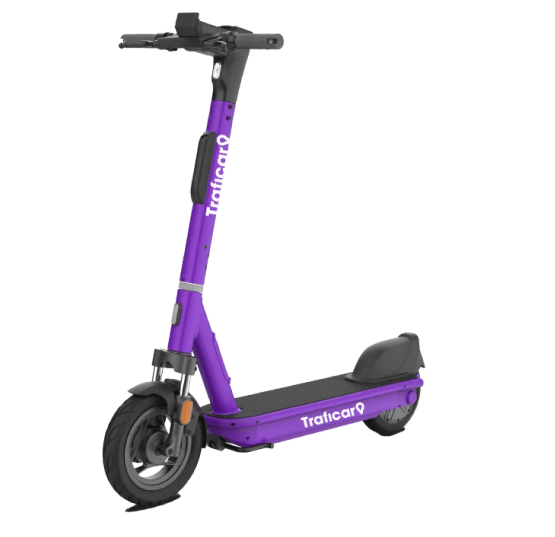Integration of e-scooters
Traficar

Company description
Traficar is the largest carsharing company in Poland with a fleet of more than 5,000 vehicles, both cars and vans, available at the click of a button on the app, which is already used by more than one million users. Traficar has been on the market since 2016 and originated from Express Car Rental, a company with nearly 30 years of experience in the automotive industry. It is part of the Polish Holding1 capital group. Cars of the Traficar service are available in 28 cities such as Warsaw, Krakow, Tricity, Poznan, Wroclaw, Lodz, Silesia, Szczecin, Rzeszow, Lublin and many others.
Project description
Core Logic was engaged to integrate Traficar’s electric scooters into an existing car sharing application. The pilot project involved the deployment of 1,000 scooters in Krakow, with the possibility of expanding to other cities in Poland. The scope of the project included not only the integration of the scooters with the mobile application, but also the creation of a full fleet management system and the connection to IoT modules installed in the scooters. The challenge was the responsibility of seamlessly connecting the mobile app, backend and fleet management of the scooters. This required close cooperation with the company supplying the modules embedded in the vehicles.
Project goals
Integration of electric scooters with Traficar's mobile application, allowing users to use a new type of vehicle.
Creation of a complete scooter fleet management system, which will ensure effective monitoring and servicing of the vehicles.
Integrating the scooters into the system through IoT modules, which will enable remote management and tracking of their status and location.
Ensure the scalability and stability of the system to support an increasing number of vehicles without performance issues.
Integration with IoT module
The biggest challenge proved to be the integration with the hardware of the scooters provided by the third-party company. The scooters were equipped with custom IoT modules, which required numerous customizations to meet Traficar’s European standards and technical requirements. During the course of the project, additional changes had to be made to the software and the IoT modules themselves, which the third-party company had to adapt to the specific needs of Core Logic and Traficar.
Course of integration
The process of integrating the mobile application and backend went smoothly, thanks to Core Logic’s previous experience in fleet management. In contrast, working with the IoT module provider was more challenging. The modules were not fully customized for use, which forced additional engineering work and requests for software and hardware changes. This additional work affected the duration of the implementation process, which ultimately took about six months.
Scalability of the system
One of the key goals of the project was to ensure that the system was efficient, scalable and stable. Accordingly, Core Logic used Kubernetes technology for container management and proprietary backend components that allow the seamless addition of new vehicles without affecting system stability. This is a significant improvement over previous solutions, where any change in the number of vehicles required additional infrastructure modification.


New functionalities in the application
As part of the project, new functions were created in the mobile application and backend system, adapted to the specifics of scooter management. Parking zones in Krakow were introduced, forcing users to leave their scooters in designated areas. In addition, a new service application was created, allowing technical teams to track the condition of the scooters, replace batteries and move vehicles between different locations.
Results
- The integration of 1,000 scooters in Krakow was successful, opening up opportunities for expansion to other cities.
- Scooters were fully integrated into the mobile application and fleet management system.
- Successful customization of the IoT modules in the scooters was carried out, enabling their effective management.
- The Kubernetes-based backend system provided scalability and stability, enabling the seamless addition of new vehicles.
- Parking zones and a service application were introduced, streamlining management of the scooters and replacement of their batteries.